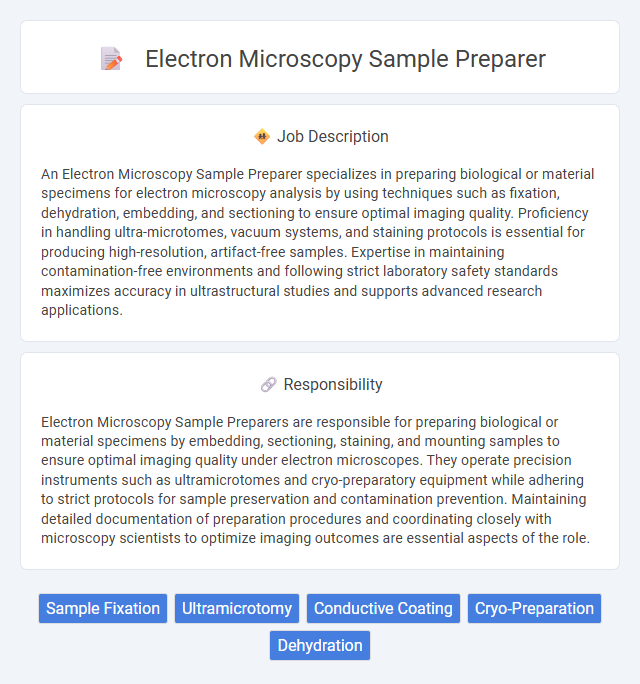
An Electron Microscopy Sample Preparer specializes in preparing biological or material specimens for electron microscopy analysis by using techniques such as fixation, dehydration, embedding, and sectioning to ensure optimal imaging quality. Proficiency in handling ultra-microtomes, vacuum systems, and staining protocols is essential for producing high-resolution, artifact-free samples. Expertise in maintaining contamination-free environments and following strict laboratory safety standards maximizes accuracy in ultrastructural studies and supports advanced research applications.
Individuals with steady hands, keen attention to detail, and strong visual acuity are likely to perform well as Electron Microscopy Sample Preparers due to the precision required in handling delicate samples. Those who find repetitive tasks challenging or have difficulties working under microscopes for extended periods may face compatibility issues with this role. It is probable that candidates with a background in laboratory work or materials science will adapt more effectively to the job demands.
Qualification
Proficiency in materials science, biology, or related fields is essential for an Electron Microscopy Sample Preparer. Candidates should possess hands-on experience with sample preparation techniques such as ultramicrotomy, cryo-preservation, and chemical fixation. Familiarity with electron microscopy equipment, safety protocols, and attention to detail ensures high-quality specimen preparation for accurate imaging results.
Responsibility
Electron Microscopy Sample Preparers are responsible for preparing biological or material specimens by embedding, sectioning, staining, and mounting samples to ensure optimal imaging quality under electron microscopes. They operate precision instruments such as ultramicrotomes and cryo-preparatory equipment while adhering to strict protocols for sample preservation and contamination prevention. Maintaining detailed documentation of preparation procedures and coordinating closely with microscopy scientists to optimize imaging outcomes are essential aspects of the role.
Benefit
Working as an Electron Microscopy Sample Preparer likely offers significant benefits such as gaining specialized skills in sample preparation techniques and operating advanced microscopy equipment. The role probably enhances understanding of material properties at a microscopic level, which can contribute to career advancement in scientific research or industrial quality control. Opportunities for collaboration with multidisciplinary teams might further improve professional networking and development.
Challenge
Electron Microscopy Sample Preparer roles likely involve significant challenges related to the precision required in sample preparation, as even minor errors can compromise imaging quality. Handling delicate samples and operating advanced instrumentation may present a high probability of requiring meticulous attention and steady dexterity. The evolving nature of electron microscopy techniques could also demand continuous learning and adaptation to new protocols, adding complexity to the position.
Career Advancement
Electron Microscopy Sample Preparers develop expertise in preparing biological, material, and chemical specimens with precision techniques such as cryo-fixation and ultra-thin sectioning. Mastery in sample preparation enhances opportunities for advancement into specialized roles including Microscopy Technician, Lab Supervisor, or Research Scientist positions. Continuous skill development in advanced imaging technologies and sample analysis fosters career growth in academic, medical, and industrial research sectors.
Key Terms
Sample Fixation
Electron Microscopy Sample Preparers specialize in sample fixation techniques to preserve cellular structures at the molecular level for high-resolution imaging. They utilize chemical fixatives such as glutaraldehyde and osmium tetroxide to cross-link proteins and stabilize lipids, preventing structural degradation during electron microscopy. Mastery of precise fixation protocols ensures artifact-free samples, enhancing image clarity and data accuracy in ultrastructural analysis.
Ultramicrotomy
Ultramicrotomy in electron microscopy sample preparation involves producing ultra-thin sections of specimens, typically less than 100 nanometers thick, to enable high-resolution imaging. The Electron Microscopy Sample Preparer meticulously adjusts the ultramicrotome settings, selects suitable diamond or glass knives, and embeds samples in resin to ensure optimal section quality. Mastery of ultramicrotomy enhances visualization of cellular structures, organelles, and nanomaterials, crucial for accurate analysis in biological and materials science research.
Conductive Coating
Electron Microscopy Sample Preparers apply conductive coatings, such as gold or carbon, to biological or material samples to enhance electron conductivity and reduce charging effects during imaging. Precise control over coating thickness, typically in the range of 1-20 nanometers, is essential to preserve sample integrity and optimize image resolution. Mastery of sputter coating and evaporation techniques ensures uniform coverage, crucial for high-quality scanning electron microscopy (SEM) analysis.
Cryo-Preparation
Specializing in cryo-preparation, an Electron Microscopy Sample Preparer expertly vitrifies biological samples through rapid freezing techniques such as plunge freezing and high-pressure freezing to preserve cellular structures at near-native states. Mastery in handling cryogenic equipment and maintaining ultraclean environments enables optimal sample integrity for high-resolution imaging in cryo-electron microscopy. Proficiency in sample mounting, cryo-transfer systems, and contamination minimization directly enhances imaging accuracy and accelerates structural biology research outcomes.
Dehydration
Dehydration in electron microscopy sample preparation involves carefully removing water from biological specimens to prevent structural damage and artifact formation during imaging. This process typically employs a graded ethanol series or acetone to gradually replace cellular water, ensuring sample integrity for high-resolution visualization under the electron microscope. Effective dehydration is critical to maintaining ultrastructural details and improving contrast in electron micrographs.
 kuljobs.com
kuljobs.com